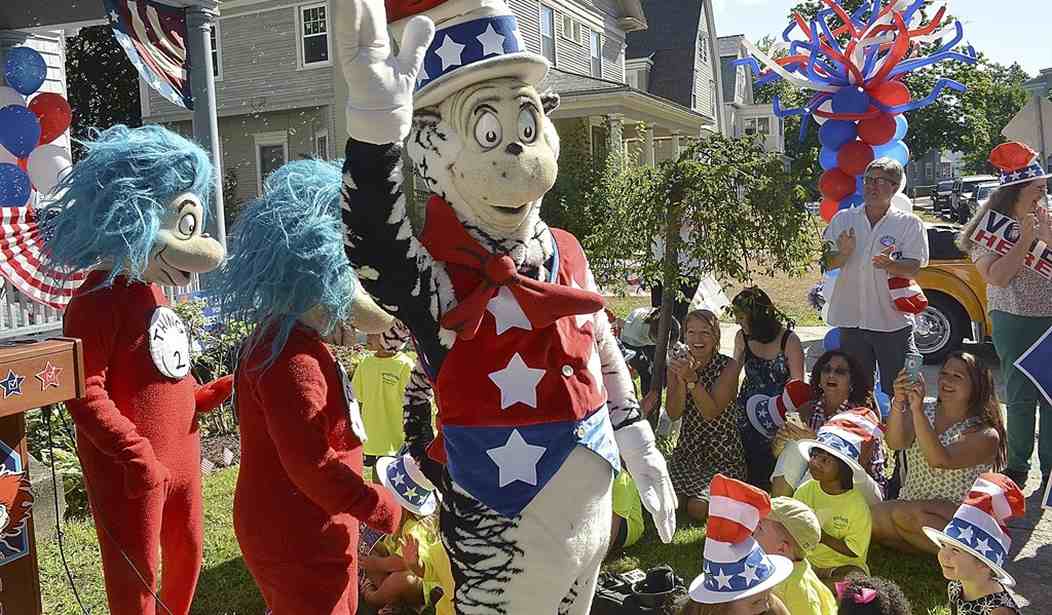The movement to cancel Dr. Seuss didn’t emerge from a vacuum. Two years before Dr. Seuss Enterprises announced it would pull five of the classic children’s author’s books, a study examined the racial makeup of characters in Theodore Seuss Geisel’s books, and found a lack of diversity. Perhaps more chillingly, a leftist education group found fault with the Dr. Seuss story “The Sneetches,” a story that explicitly condemns racism.
Back in 2019, the Southern Poverty Law Center’s (SPLC) education arm, Teaching Tolerance (now rebranded “Learning for Justice”), condemned “The Sneetches” as insufficiently “anti-racist.” The story condemns racism, sure, but it fails to use Marxist critical race theory to turn children into activists. You see, it’s not enough to oppose racism — you have to militate against “systemic racism” and the “white supremacy” latent in American society.
Back in March 2019, the SPLC’s Gabriel Smith acknowledged that Teaching Tolerance had “featured anti-racist activities built around the Dr. Seuss book The Sneetches. But when we re-evaluated, we found that the story is actually not as ‘anti-racist’ as we once thought. And it has some pretty intricate layers you and your students might consider, too.”
For those unfamiliar with the story, “The Sneetches” involves two kinds of creatures, “the Star-Belly Sneetches” with stars on their bellies and the “Plain-Belly Sneetches” without any stars on their stomachs. The Star-Belly Sneetches discriminate against the Plain-Belly Sneetches, excluding them from beach games, picnics, and other activities. Then a man comes by with a machine to add stars and another machine to remove stars. This confuses the Sneetches, who vacillate between having stars and not having stars, until no one knows who is who.
In the end, the Sneetches “got really quite smart” and concluded “that Sneetches are Sneetches/And no kind of Sneetch is the best on the beaches.”
Digital Book Burning Comes for Dr. Seuss — on His Birthday
Yet “Teaching Tolerance” didn’t like that ending, no, not one bit. It won’t serve to radicalize one little kid. You’ve got to teach children that they are oppressed, and reject the acceptance that Dr. Seuss stressed.
“The solution to the story’s conflict is that the Plain-Belly Sneetches and Star-Bellied Sneetches simply get confused as to who is oppressed. As a result, they accept one another,” Smith wrote for Teaching Tolerance.
“This message of ‘acceptance’ does not acknowledge structural power imbalances. It doesn’t address the idea that historical narratives impact present-day power structures. And instead of encouraging young readers to recognize and take action against injustice, the story promotes a race-neutral approach,” the SPLC writer complained.
Dr. Seuss’s original message promotes acceptance and individuality over the idea of toppling a supposed racial oppression that hides behind American society. This achieves the opposite result of the SPLC.
Last month, the SPLC published its annual “Year in Hate” report, urging the federal government to “address far-right and racist narratives” by providing “funding for the Department of Education to develop a curriculum on structural racism and funding for states to implement their own related initiatives.”
“Americans can only dismantle white supremacy if they understand how racism shaped (and continues to shape) housing, education, policing, health care and other policies and practices that affect our everyday lives,” the SPLC report claimed.
The very next day, the SPLC announced it would revamp its “Teaching Tolerance” program — which spreads its far-left agenda in schools — renaming the program “Learning for Justice.”
“We are called as educators, justice advocates, caregivers and students to reimagine and reclaim our education system so that it is inclusive and just,” Jalaya Liles Dunn, the new Learning for Justice director, argued (emphasis added). “In shifting from Teaching Tolerance to Learning for Justice, we’re offering an urgent call to action: We must learn, grow and wield power together” (bold emphasis added, italics original).
This Activist’s Marxist Brainwashing Explains Why Antifa Has Terrorized Portland for 51 Nights
The SPLC has long pushed leftist activism in schools through the Teaching Tolerance program, but this explicit call to “reimagine” the education system and use it to “wield power” seems brazen, even for an organization infamous for using “hate group” labels to demonize its opponents and bilk donors. Education should not be about “wielding power” but about teaching reading, writing, and arithmetic — and training kids to think freely and be good citizens.
The SPLC wants schools to turn children into leftist activists, training them to deconstruct American society to find hidden racism everywhere, and encouraging them to “wield power” by eradicating it.
Critical race theory teaches that the central aspect of society is racial oppression — the historic abuses white people have committed against people of other races. “White supremacy” secretly rules everything, even when policies explicitly consider people on the content of their character rather than the color of their skin. It does not matter that American law expressly forbids racial discrimination, according to this theory. If white people have more money than black people, that is ipso facto proof of white supremacy, regardless of how Asians are doing and regardless of the true reasons behind any disparity.
The Smithsonian briefly showed how this works when it published a “teaching tool” infographic on “whiteness.” That infographic claimed that the nuclear family, science, capitalism, the Judeo-Christian tradition, individualism, “objective, rational linear thinking,” and even values such as “be polite” are aspects of oppressive whiteness. The Smithsonian rightly removed the graphic after facing criticism, but a similar mindset arguably drives the SPLC’s paranoid demonization of mainstream conservative Christian nonprofits as “hate groups.”
Marxist critical race theory inspired much of the destruction of the Black Lives Matter and antifa riots over the summer. While protesters rightly expressed outrage at the treatment of George Floyd, many of the protests devolved into looting, vandalism, and arson in which lawless thugs — acting in the name of fighting racism — destroyed black lives, black livelihoods, and black monuments.
During the mayhem, President Donald Trump designated antifa a terrorist organization. The SPLC condemned Trump’s move as “dangerous and unjust.” The SPLC pushed the narrative that police were “punishing peaceful protest” even as rioters were burning down buildings and throwing Molotov cocktails at law enforcement.
The message of Dr. Seuss’ “The Sneetches” is at odds with the stated goal of “Learning for Justice.” The group doesn’t aim to promote mutual understanding but rather to promote an insidious ideology that turns students into grievance activists.
Theodore Seuss Geisel had a complex legacy. While he is rightly best known for his wonderful children’s books, the man also worked as a propaganda cartoonist, and some of his cartoons during World War II did use racist tropes to demonize the Japanese. Cartoonists during the war routinely used racism to demonize the Axis enemies. Yet Geisel himself grew up in an era of anti-German prejudice, so he experienced discrimination firsthand.
Geisel’s greatest legacy involved the promotion of literacy among children through the Dr. Seuss books. Those books may have featured more “white” characters than characters “of color,” but that makes sense given their time and place in 1950s America. As “The Sneetches” suggests, Geisel would undoubtedly feature more minorities in the books if he wrote them today.
The rush to cancel Dr. Seuss has less to do with his truly offensive wartime cartoons and more to do with the Left’s increasing radicalization. Learning for Justice cannot brook the old attack on racism, which encouraged people to look beyond skin color to an individual’s character. Now, the Left encourages supposedly oppressed minorities to band together according to skin color and to throw off the “chains” of Western society — the very society that has lifted more people out of poverty than any other.
The rejection of “The Sneetches” provides a chilling example of just how far “anti-racism” has gone — and how dangerous it has become.
Tyler O’Neil is the author of Making Hate Pay: The Corruption of the Southern Poverty Law Center. Follow him on Twitter at @Tyler2ONeil.









Join the conversation as a VIP Member